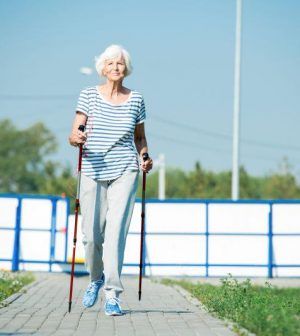- Navigating Your Midlife Crisis: Embracing New Possibilities
- City Raccoons Showing Signs of Domestication
- Mapping the Exposome: Science Broadens Focus to Environmental Disease Triggers
- One Week Less on Social Media Linked to Better Mental Health
- Your Brain Changes in Stages as You Age, Study Finds
- Some Suicide Victims Show No Typical Warning Signs, Study Finds
- ByHeart Formula Faces Lawsuits After Babies Sickened With Botulism
- Switch to Vegan Diet Could Cut Your Greenhouse Gas Emissions in Half
- Regular Bedtime Does Wonders for Blood Pressure
- Dining Alone Could Mean Worse Nutrition for Seniors
Walking Your Way to Better Health

Walking is one of the best exercises available to average folks, and it can be as easy as stepping out your front door, experts say.
“It is something you can easily fit into your lifestyle,” said Dr. James McDeavitt, professor of physical medicine and rehabilitation and executive vice president and dean of clinical affairs at Baylor College of Medicine.
Walking has been shown to improve heart health and contribute to better mental health. It can even ward off osteoporosis by toughening up bones, McDeavitt added.
Walking also serves as a wonderful entry point for someone looking to improve physical activity, since it involves less wear and tear on the joints than running.
Even for people with health problems that impair mobility, walking is a good exercise option, McDeavitt said. Indoor running tracks provide a safe environment, particularly if someone has the company of a caregiver or loved one.
However, treadmills and other automated cardio machines should be avoided by those with severe mobility issues, as there’s a greater risk of injury with those devices.
Folks who’ve been inactive should start by consistently walking five to 10 minutes a day, and then gradually increasing that time, McDeavitt said.
McDeavitt recommends walking at a low intensity for a longer duration to get the most out of walking, rather than trying to power-walk.
However, walking at a faster pace can intensify a walk just as well as adding ankle or wrist weights, without the extra hassle, McDeavitt added.
Walking shoes should have a stiff rubber or athletic sole, and fit well with some wiggle room in the toe area, McDeavitt said.
People should also buy shoes with arch support and cushioning, as well as shoes that sit higher on the ankle if they need more stability for walking on uneven terrain.
Folks who start to experience rubbing, chafing or red spots should visit a running shoe store, McDeavitt said. The experts there will generally be able to find a shoe that fits a person’s specific needs.
Walkers also should feel free to mix in other forms of exercise, to provide the added benefits of cross-training.
“Mixing up your routine will improve cardiovascular fitness, so look to add in resistance and strength training with weights to improve bone health,” McDeavitt said in a Baylor news release. “Low intensity exercise mixed with high intensity exercises for at least 30 minutes each will allow you to get the most out of your physical routine and lead to overall better well-being.”
SOURCE: Baylor College of Medicine, news release, April 14, 2024
Source: HealthDay
Copyright © 2025 HealthDay. All rights reserved.










